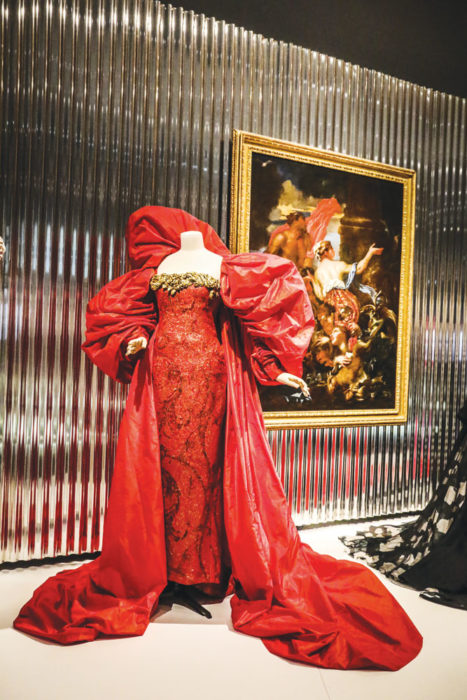
Seventy-one years of the iconic fashion house, chronicled by its haute couture creations.
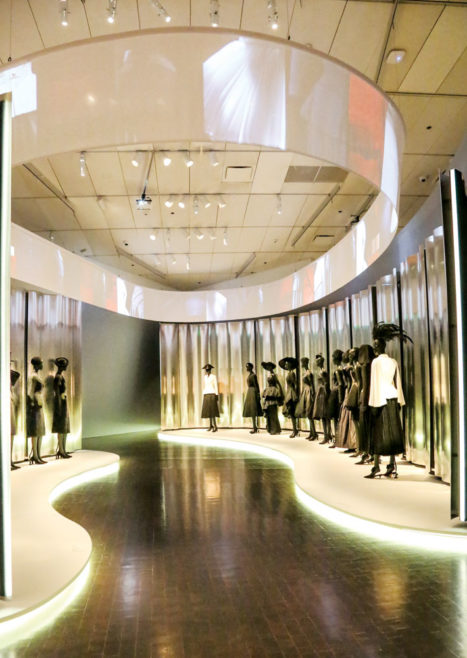
The curving entrance to the show displays work by all seven House of Dior designers.
Female beauty and flowers were two of Christian Dior’s favorite things. “After women, flowers are the most lovely thing God has given the world,” he wrote in The Little Dictionary of Fashion, published in 1954. Dior directed several art galleries before opening his own couture house in 1947, which revolutionized the world of fashion.
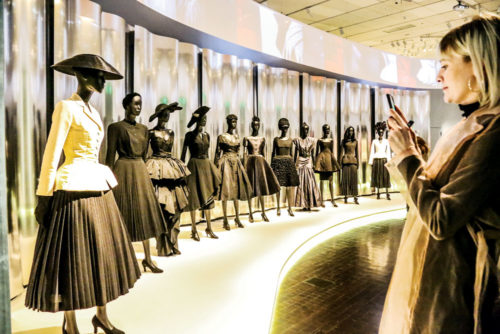
The Bar suit at far left was created by Christian Dior himself in 1947 and became the manifesto of a new style that Dior called the “flower-woman.”
Dior: From Paris to the World, at the Denver Art Museum through March 3, surveys 71 years of the House of Dior’s enduring legacy and its global influence. The story of the iconic haute couture fashion house is told with a selection of 200 dresses, as well as accessories, photographs, original sketches and runway videos.
Haute couture, literally “high sewing” in French, refers to the most fashionable and influential dressmaking and designing. The House of Dior has enjoyed a continuity that is rare in the fashion world. “If you look at the great French couture houses, Dior is perhaps the only one that has no gap in its history,” said Florence Müller, the DAM’s Avenir Foundation Curator of Textile Art and Fashion.
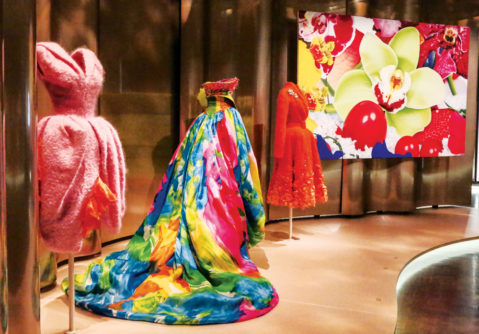
Dior’s love of beautiful dresses was equaled only by his passion for gardening. The paintings of the Impressionists, especially Renoir and Monet, inspired his floral embroideries and layered petals of fabric.
The architectural design of the exhibit is surprising and engaging, as visitors move through flowing sections based on curves rather than square gallery spaces. “It’s organic, like a river or a garden wall,” said exhibit designer Shohei Shigematsu of the Office of Metropolitan Architecture (OMA). “We were inspired by the Hamilton building itself, with its titanium-clad exterior, to install curved aluminum panels to reflect the fashions. The curves are taken from the cut of the dresses.”
Dior generated a fashion revolution in 1947 with his New Look collection (so named by Harper’s Bazaar). In reaction to the boxy, masculine looks of wartime fashion, Dior designed a succession of curves, with rounded shoulders, a generous bust, a tiny waist and accentuated hips.
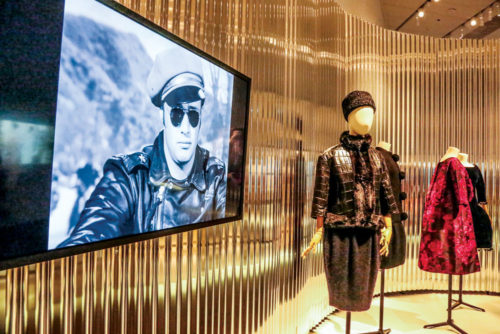
Yves Saint Laurent, Dior’s first successor, quoted street style, pop culture and the movies in his 1960 collection. His black leather Chicago ensemble took its cue from the rebel biker immortalized by Marlon Brando in the 1953 film, The Wild One.
Not everyone applauded his pioneering vision. Protesters in Paris, a city still bullet-pocked and recovering from wartime austerity, tore the gowns off models in the streets to denounce Dior’s wasteful use of fabric. But the style carried the day because it expressed the craving for bygone glamour.
Dior died of a heart attack in 1957, leaving the helm of the House of Dior to six successive art directors, who have carried his vision into the 21st Century: Yves Saint Laurent (1958–1960), Marc Bohan (1961–1989), Gianfranco Ferré (1989–1996), John Galliano (1997–2011), Raf Simons (2012–2015) and Maria Grazia Chiuri (2016–present).
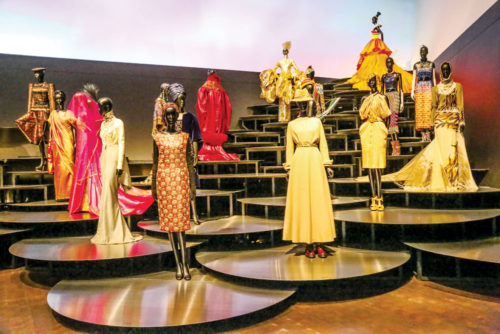
Inspired by many cultures: fashions by Dior and his successors evoke the art and cultures of Spain, England, Japan, China, Africa, Egypt and Latin America, as well as Chicago and New York.
Dior’s inspirations included modern art, the movies, the flamboyance of 18th century France, and his garden, where he often sat while designing. Many of these themes, especially the feminine aesthetic he embraced, remain to the present day through his successors. “Dior’s successors continued his signature feminine shapes, like the figure 8,” said Christy Cheng of OMA exhibit design.
The House of Dior’s creative process remains as well. Once the designer comes to the head of the atelier (workshop) with a set of designs, the designs are created in white cotton, called toiles. When approved, the toiles are disassembled and the pieces are used as the pattern for the final garments. Visitors will see a wall of toiles.
Since haute couture gowns can cost thousands of dollars, they are most often worn by well-heeled patrons. Dior loans its gowns to celebrities for such events as the Academy Awards. Jennifer Lawrence, Charlize Theron, Natalie Portman and Rihanna have all worn Dior gowns on the red carpet. Visitors will see a chartreuse chinoiserie silk gown worn by Nicole Kidman, as well as a flower-embroidered dress worn by Natalie Portman.
A display from the golden age of fashion photography shows Dior’s fashions on such luminaries as Audrey Hepburn and Marilyn Monroe.
Christian Dior travelled extensively and established the House of Dior on five continents—Africa, Asia, Europe, North America and South America. World art and cultures continue to be a source of inspiration for his successors, as displayed in the final gallery.



Fabulous show in Dallas. Wish they had a wall of famous celebrities in his designs. Mary Monroe, Audrey Hepturn, etc. Only few photos. Too few pictures.